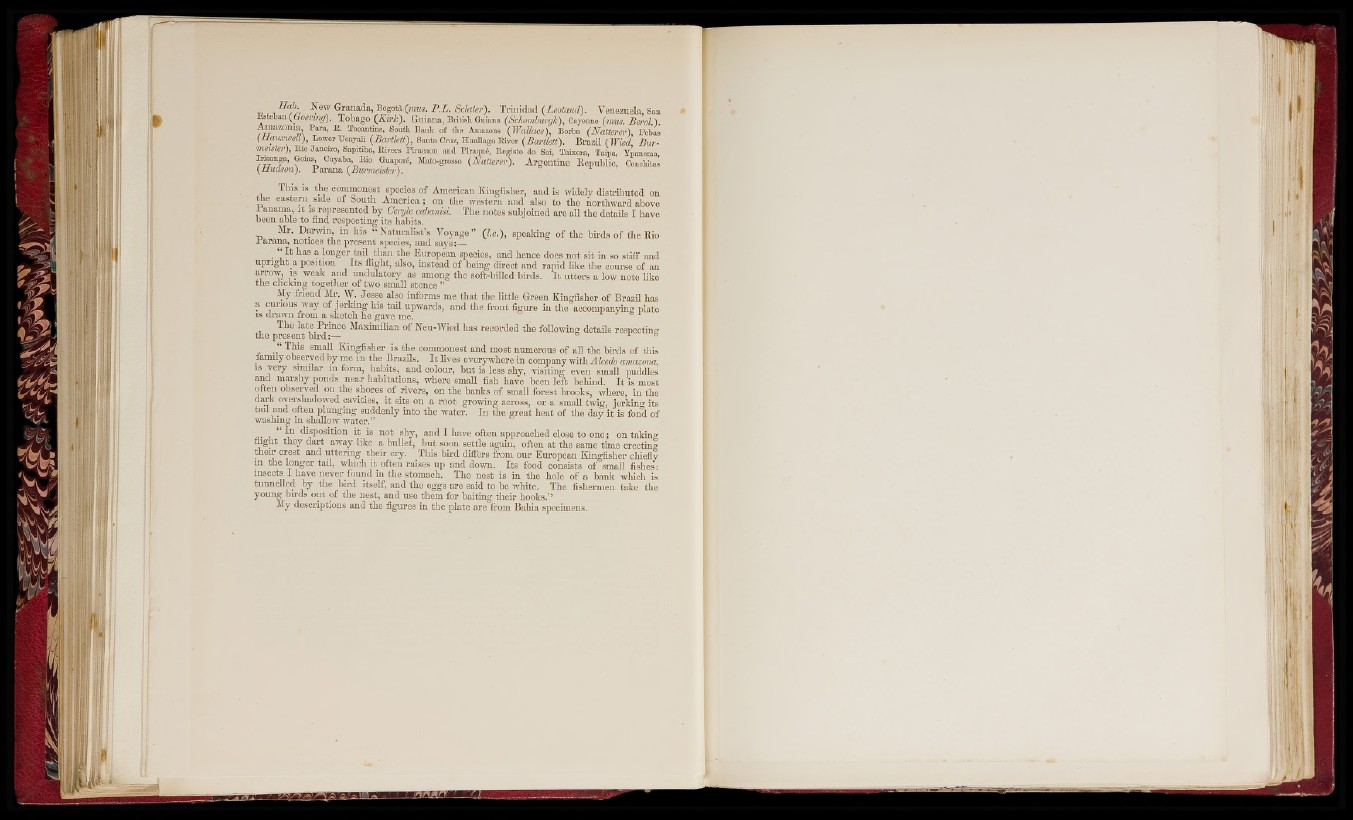
V t S»?»“ (“ “ »• P L - S d a i p . T rin id ad (LeotauS). Venezuela, San
s ebau Tobago (K irk ). Guiana, Britieli Guiana (Schomhurgk), Cayenne (mus. Berol.).
Amazonia, Para, E. Tocantins, South Bank of the Amazons {Wallace), Borba (Natterer). Pebas
{Hauxwell), Lower Ucayali {Bartlett), Santa Graz, Huallaga Eivor {Bartlett). Brazil ( Wied Bur-
w m f e r ) , Eio Janeiro, Sapitiba, Elvers Pii-acaon and Piraquó, Eegisto do Sai, Taixora, Taipa, Ypanema,
n ^ a n g a , G o ia^ Cuyaba, Eio Guapote, Mato-grosso {Natterer). A rg cn tm e Republic, Conchitas
{Hudson). P a ran a {Burmeister). ' c, i ,
Th is IS th e commonest species o f American Kingfisher, and is widely d istrib u ted on
to e eastern ^ side o f South A m e ric a ; on toe western and also to the n o rthw ard above
f anama, i t is represented b y Ceryle cabanisi. The notes subjoined are all the details I have
been able to h u d respe cting its habits.
Mr. Darwin in h is “ N a tu ra lis t’s V o y ag e ” (I.e.), speaking o f tho bfrds o f th e Rio
P a ran a , notices the p resen t species, and says:—
_ “ I t has a lo n g er ta il th an th e European species, and hence does n o t s it in so stiff and
u p r ig h t a po sitio n I ts flight, also, instead o f being direct aud rap id like the course o f an
arrow, is weak an d u n d u lato ry as among th e soft-billed bfrds. I t u tte rs a low note like
tn e clicking to g eth e r o f two small stones ”
U y friend Mre r.. W, .. T . informs me th a t the little Green Kingfisher o f Brazil has
a curious way o f je rk in g his ta il upwards, and th e fro n t figure in the accompanying p late
IS d raw n from a sketch he gave me. r j o l
to e p r i e n f b i i r i * ’^'^^ Maximtoan o f Neu -Wied has recorded the foHowiug details respecting
“ This small Kingfisher is th e commonest an d most numerous o f aH th e bird s o f this
family observed by me in tbe Brazils. I t lives everywhere iu company wdth Alcedo amazona,
IS v e ry similai- m form, habits, aud colour, b u t is less shy, visitin g even small puddles
an d m arsh y ponds n e a r hab itatio n s, where small fish have been left behind. I t is most
often observed on the shores o f rive rs, on th e banks o f small forest brooks, where, in the
d a rk overshadowed cavities, i t sits on a ro o t growing across, o r a small twig, jerkinn- its
tail and often p lu n gm g suddenly in to the water. In th e g re a t heat o f th e day i t is fond of
washing m shallow w a te r.”
“ In disposition i t is n o t shy, aud I have often approached close to o n e ; on tak in g
flight th ey d a rt away like a bullet, b u t soon se ttle again, often at the same time erecting
to e ir cre st and u tte rm g th e ir cry. This b ird differs fi-om o u r European Kingfisher chiefly
m th e lon g er tail, which i t often raises u p and down. I ts food consists o f smaU fishes:
insects I have n ev er found in th e stomach. The nest is in th e hole o f a bank wliich is
tu n n elled b y th e b ird itself, an d th e eggs are said to be white. The fishermen take toe
y o u n g bird s o u t o f th e nest, and use th em for b aiting th e ir hooks.’’
My descriptions and the figures in th e p late are from Bahia specimens.
I'l